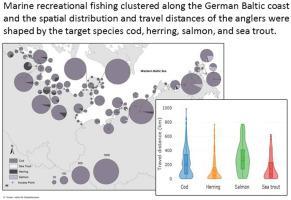Ocean & Coastal Management ( IF 4.8 ) Pub Date : 2021-04-21 , DOI: 10.1016/j.ocecoaman.2021.105640 W.-C. Lewin , M.S. Weltersbach , K. Haase , H.V. Strehlow

|
The marine recreational fishery (MRF) is a branch of coastal tourism with noticeable effects on fish stocks, coastal environments, and economies. Nevertheless, little research has been conducted on its spatio-temporal dimensions. This study extends the knowledge about marine angling tourism by investigating activity hot spots and travel distances of 8429 German Baltic Sea anglers using data obtained from an on-site survey which was conducted from 2015 to 2019. Fishing from shores, small boats, and charter vessels, the anglers targeted primarily Atlantic cod and to a lesser extent sea trout, salmon, and herring. Angling effort clustered along the coast primarily according to the available infrastructure and the spatial distribution of the target species. The medians of travel distances differed among the target species and decreased from salmon (261 km), cod (194 km), sea trout (63 km) to herring (44 km). The high percentage of non-resident anglers, most of whom travelled more than 200 km to the coast, suggested that particularly cod and salmonid anglers conducted multiple-day trips and contributed to local economies. The period 2016/17 was characterised by a severe decline of the western Baltic cod stock and the first-time implementation of harvest limitations. The number and travel distances of cod charter vessel anglers decreased after the implementation, whereas the numbers and travel distances of boat and shore anglers targeting cod remained constant despite overall decreasing catch rates. The delineation of areas where marine recreational fishing concentrates may help to define areas relevant for tourism development and destination branding and equally those that require a risk assessment to evaluate the potential extent and consequences of MRF on local environments. The travel distances underlined the heterogeneity of the MRF and may be used as tool to identify stakeholder groups, to estimate the species-specific attractiveness for resident and non-resident anglers, and to evaluate the outcome of management actions.
中文翻译:

谁能走多远:德国波罗的海垂钓者的行进距离是渔业管理和沿海空间规划的前提
海洋休闲渔业(MRF)是沿海旅游业的一个分支,对鱼类种群,沿海环境和经济产生显着影响。然而,关于其时空维度的研究很少。这项研究使用从2015年到2019年进行的现场调查获得的数据,调查了8429个德国波罗的海垂钓者的活动热点和旅行距离,从而扩展了海洋垂钓旅游的知识。 ,垂钓者的主要目标是大西洋鳕鱼,其次是海鳟,鲑鱼和鲱鱼。垂钓工作主要是根据可用的基础设施和目标物种的空间分布沿海岸聚集。在目标物种之间,行进距离的中位数有所不同,从鲑鱼(261 km),鳕鱼(194 km),海鳟(63 km)到鲱鱼(44 km)减小。非居民垂钓者的比例很高,其中大多数人到沿海旅行超过200公里,这表明鳕鱼和鲑鱼垂钓者尤其进行了多日游,并为当地经济做出了贡献。2016/17年期间的特点是,波罗的海西部鳕鱼存量急剧下降,首次实施了收成限制措施。实施后,鳕鱼租船垂钓者的数量和行进距离减小,而捕捞鳕鱼的船只和岸上垂钓者的数量和行进距离保持恒定,尽管捕捞率总体下降。划定海洋休闲捕捞集中区可能有助于界定与旅游业发展和目的地品牌相关的区域,同样也需要进行风险评估以评估MRF对当地环境的潜在程度和后果的区域。行进距离突显了MRF的异质性,可以用作确定利益相关者群体,评估居民和非居民垂钓者对特定物种的吸引力以及评估管理措施的结果的工具。











































 京公网安备 11010802027423号
京公网安备 11010802027423号